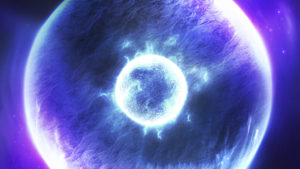[Guest contributor Jeremy Dunning-Davies offers a new perspective on the recent Voyager 1 data and the latest all-sky survey.]
Thoughts Occasioned by Two Recent Announcements
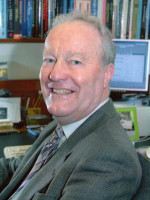 Jeremy Dunning-Davies
Jeremy Dunning-Davies
Department of Physics, University of Hull, England.
Abstract
Fairly recently, two announcements concerning astrophysical observations appeared. The first from NASA mentioned the fact that the Voyager 1 spacecraft had detected a 100-fold increase in the intensity of high-energy electrons from elsewhere in the galaxy diffusing into our solar system from outside; the other revealed that a new all-sky map showed the magnetic fields of the Milky Way with the highest precision and proceeded to point out that the origin of galactic magnetic fields remains unknown despite intensive research, although it seemingly assumed that they are constructed via dynamo processes, such as are said to occur in the interiors of the Earth and the Sun. Here it is pointed out that plasma cosmology/electric universe theory can, and does, offer viable solutions to these and other supposed problems faced by orthodox cosmology.
On 5th December, NASA announced that its Voyager 1 spacecraft had entered a new region between our solar system and interstellar space. All the details may be viewed at
http://www.jpl.nasa.gov/news/news.cfm?release=2011-372
In this announcement, one of the more interesting comments is that “Voyager has detected a 100-fold increase in the intensity of high-energy electrons from elsewhere in the galaxy diffusing into our solar system from outside”. This comment is of interest because, apart from the word ‘diffusing’, it describes what the electrical model of our universe expects in the virtual cathode region of the solar discharge boundary.
Also, on 6th December, it was revealed that a new all-sky map shows the magnetic fields of the Milky Way with the highest precision
http://www.physorg.com/news/2011-12-all-sky-magnetic-fields-milky-highest.html
It was claimed that the origin of galactic magnetic fields remains unknown despite intensive research, although it was seemingly assumed that they are constructed via dynamo processes such as are said to occur – in violation of Cowling’s well-known theorem incidentally – in the interiors of the Earth and the Sun.
Some years ago, in an entirely different context, Sir Winston Churchill advised people to learn from the lessons of history and, in the present context, it might seem appropriate to follow this advice in astrophysics. Hence, in this spirit, it might be noted that, following the introduction of Newton’s mechanical ideas, work still proceeded apace investigating electromagnetic phenomena and this continued at least into the earlier years of the twentieth century, as is evidenced by the contents of J. J. Thomson’s book Electricity and Matter [1]. However, this book provides but one example to illustrate the very real emphasis on work involving the effects of the electric and magnetic fields, work which, incidentally, constantly sought an explanation for the concept of mass in terms of those forces. However, after those early years of the century, the emphasis seems to have shifted to explanations of phenomena purely in terms of gravitational effects. Considering that it is accepted that much of the matter in the universe is in the form of plasma, this seems a retrograde step. One may only speculate as to why the emphasis of much scientific research changed in this way. However, thanks to people like Birkeland, Alfvén and, more recently, Peratt, work in the areas of electromagnetism and plasma physics has continued.
The work on plasmas and other electromagnetic phenomena has inspired people to examine astronomical phenomena in these terms and this has resulted in the so-called Electric Universe idea as expounded, for example, in the books The Electric Universe [2] and The Electric Sky [3]. Reading through this material makes one immediately aware that just like accepted theory the electric universe ideas are supported by computer modelling, but it is also able to draw on parallels between astronomical phenomena and plasma phenomena observed in the laboratory. Admittedly, drawing such parallels involves scaling up tremendously but assuming this possible is little different from assuming that laws seemingly applicable here on the Earth are also applicable in the Solar System and, indeed, throughout the universe. At least visually, some of the phenomena observed in the laboratory are very like what is observed by some of the most powerful of telescopes. Electric currents in plasma naturally form filaments due to the so-called ‘pinch effect’ of the induced magnetic field. Electromagnetic interactions cause these filaments to rotate about one another to form a helical ‘Birkeland Current’ filament pair and this is very much the structure seen in the Double Helix nebula near the galactic centre; again, the Hubble image of the planetary nebula NGC6751 looks remarkably like the view down the barrel of a plasma focus device. Examples such as these prove nothing but might awaken people to the possibility of alternative explanations for at least some astronomical phenomena.
Much of the laboratory work originated with the work of Kristian Birkeland more than one hundred years ago. It was during his Arctic expeditions at the end of the 19th century that the first magnetic field measurements were made of the Earth’s polar regions. His findings also indicated the likelihood that the auroras were produced by charged particles originating in the Sun and guided by the Earth’s magnetic field. Birkeland, though, was an experimentalist and is still known for his Terrella experiments carried out in a near vacuum and in which he used a magnetised metallic sphere to represent the Sun or a planet and subjected it to electrical discharges. By this means, he was able to produce scaled down auroral-type displays as well as analogues of other astronomical phenomena. These claims, however, were only vindicated finally by satellite measurements in the 1960’s and 70’s. To that point in time, his experimental and observational achievements had tended to be overshadowed by the purely theoretical predictions and explanations of the geophysicist, Sydney Chapman. Powerful mathematics seems to have held sway over the more expected techniques of physics – experimentation and observation, with mathematics a mere tool to be used when necessary. This is not to decry Chapman’s work but to emphasise the overwhelming importance of the physics when investigating natural phenomena.
Birkeland also showed experimentally that electric currents tend to flow along filaments shaped by current induced magnetic fields. Of course, this confirmed observations of Ampère that indicated that two parallel currents flowing in wires experience a long range attractive magnetic force that brings them closer together. However, as plasma currents come closer together, they are free to rotate about each other. Such action generates a short range repulsive magnetic force which keeps the filaments separated so that they are, in effect, insulated from each other and able to maintain their separate identities. The end effect is for them to appear like a twisted rope and it is this configuration which is termed a ‘Birkeland current’. Satellites orbiting above the auroras in the 60’s and 70’s were able to detect a movement of ions, indicating that electric currents were present. Later missions found quasi-steady electric fields above the auroras following the magnetic field lines, thus lending some credence to Birkeland’s claim of the existence of an electric circuit between the earth and the Sun.
However, the so-called Electric Universe is really just an hypothesis, a new way of interpreting known data by using both new and well-established knowledge relating to electricity and plasma. It should be emphasised immediately that, in this new interpretation, gravity still has a role to play but it is a secondary one since the electric force is so much more powerful. A major point to be stressed from the outset is that, in this interpretation of astronomical phenomena, scientists are able to call on evidence from laboratory based experiments to help form and support suggested explanations for a wide variety of phenomena. It has been found that, as explained in more detail in the above-mentioned books, a plasma in a laboratory is a good model for providing possible explanations for many recently observed astronomical phenomena which, in several cases, have puzzled astronomers seeking explanations via more usual routes. This is not to say that gravity is ignored and regarded as irrelevant; rather, the possible effects of the electromagnetic force on astronomical phenomena are investigated while still recognising the importance of gravitational effects. In the electric universe, the gravitational systems of galaxies, stars, moons and planets are felt to have their origins in the proven ability of electricity to generate both structure and rotation in plasma. It is felt further that the force of gravity assumes importance only as the electromagnetic forces approach equilibrium. As has been noted already, great consternation has been caused in astronomical circles by the realisation that gravity, as presently understood, cannot explain much that is observed if the amount of mass available is as now felt to be present. Hence, instead of positing the existence of ‘dark matter’ or following the path of modifying Newton’s well-tried law of gravitation significantly, it is suggested here that the effects of the electromagnetic force be examined to see if, in conjunction with orthodox ideas on gravity, these puzzling observations can be explained. However, returning to the realisation that much of the matter permeating the Universe is in the form of plasma, it might be remembered that these clouds of plasma respond to the well-known laws of Maxwell. Also, as pointed out by Scott in his book [3], another law, formulated by Lorentz, does help explain the galactic speeds alluded to earlier. This law states that:
a moving charged particle’s momentum (speed or direction) can be changed by application of either an electric field or a magnetic field or both.
This seems a highly likely contributory factor, at least, causing galaxies to rotate as they are perceived to do but would indicate, contrary to the accepted view, that gravity has less to do with things than has been thought. However, it should be noted that nowhere is it being suggested that Newton’s law of gravitation is in error; it is simply being suggested that, in deep space where everything swims in a sea of plasma, the Maxwell – Lorentz electromagnetic forces dominate over those of gravity.
It might be remembered also that the Lorentz force alluded to here changes a charged particle’s momentum and that change is directly proportional to the strength of the magnetic field through which the particle is moving. Further, the strength of a magnetic field produced by an electric current is inversely proportional to the distance from the current but the gravitational force between stars is inversely proportional to the square of the distance. This well-known difference between the two forces could lie at the heart of the problem of the galactic rotation curves; certainly it seems an avenue worth exploring further, especially considering the fact that more and more space missions are indicating that electromagnetic forces are distributed more widely throughout space and are, of course, many orders of magnitude stronger than gravitational forces.
As well as a great many laboratory experiments being performed to establish plasma properties [4] , it has been shown also, using the Maxwell and Lorentz equations, that streams of charged particles, such as are found in the intergalactic plasma, will evolve into the familiar galactic shapes under the influence of electromagnetic forces. The results fit extremely well with the observed velocity profiles in the galaxies and all this with no recourse to missing mass. Much of this simulation work has been carried out by Anthony Peratt and is reported in various issues of the IEEE Transactions on Plasma Science.
Jeremy Dunning-Davies
References
1. J. J. Thomson, Electricity and Matter, Westminster: Archibald Constable & Co., 1904.
2. W. Thornhill and D. Talbott, The Electric Universe, Portland, Mikamar Publishing, 2002.
3.[a],[b] D. E. Scott, The Electric Sky, Portland, Mikamar Publishing, 2006.
4. A. Peratt, Physics of the Plasma Universe, New York, Springer-Verlag, 1992.
A Nobel Prize for the Dark Side
“Science today is about getting some results, framing those results in an attention-grabbing media release and basking in the glory.” —Kerry Cue, Canberra Times, 5 October 2011
On October 4, 2011 the Nobel Prize in Physics was awarded to three astrophysicists for “THE ACCELERATING UNIVERSE.” Prof. Perlmutter of the University of California, Berkeley, has been awarded half the 10m Swedish krona (US$1,456,000 or £940,000) prize, with Prof. Schmidt of the Australian National University and Prof. Riess of Johns Hopkins University’s Space Telescope Science Institute sharing the other half. The notion of an accelerating expansion of the universe is based on observation of supernovae at high redshift, known as The High-Z SN Search.
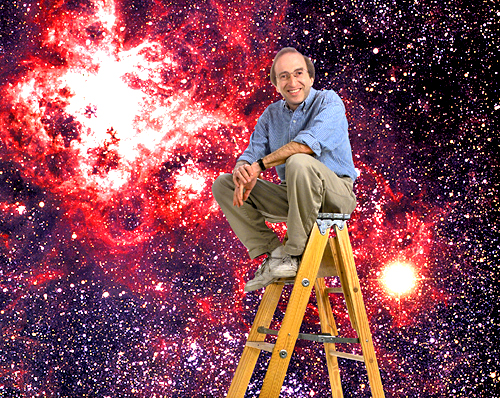
Saul Perlmutter pictured with a view of the supernova 1987a in the background. Photo: Lawrence Berkeley National Laboratory

Brian Schmidt of the Australian National University. Photo by Belinda Pratten.
However, accelerating expansion requires a mysterious source of energy in space acting against gravity, dubbed “dark energy.” Calculations show that the energy required is equivalent to 73% of the total mass-energy of the universe! Historians will look back at science today with disbelief and amusement at the ‘science’ of today. Following equally mysterious ‘black holes’ and ‘dark matter,’ if we continue to discover darkness at the present rate we shall soon know nothing!
“The present boastfulness of the expounders and the gullibility of the listeners alike violate that critical spirit which is supposedly the hallmark of science.”
—Jacques Barzun, Science: the glorious entertainment

Dr. Tamara Davis
I attended a public lecture recently on “Cosmological Confusion… revealing the common misconceptions about the big bang, the expansion of the universe and cosmic horizons,” presented at the Australian National University by an award winning Australian astrophysicist, Dr. Tamara Davis.
The particular interests of Dr. Davis are the mysteries posed by ‘dark matter’ and ‘dark energy,’ hence the title of this piece. The theatre was packed and the speaker animated like an excited schoolchild who has done her homework and is proud to show the class. Her first question to the packed hall was, “How many in the audience have done some physics?” It seemed the majority had. So it was depressing to listen to the questions throughout the performance and recognize that the noted cultural historian Jacques Barzun was right. Also, Halton Arp’s appraisal of the effect of modern education seemed fitting:
“If you take a highly intelligent person and give them the best possible, elite education, then you will most likely wind up with an academic who is completely impervious to reality.”
Carl Linnaeus in 1758 showed characteristic academic hubris and anthropocentrism when he named our species Homo sapiens sapiens (“Sapiens” is Latin for “wise man” or ” knowing man”). But it is questionable, as a recent (18th August) correspondent to Nature wrote, whether we “merit a single ‘sapiens,’ let alone the two we now bear.” To begin, big bang cosmology dismisses the physics principle of no creation from nothing. It then proceeds with the falsehood that Hubble discovered the expansion of the universe. He didn’t, he found the apparent redshift/distance relationship (actually a redshift/luminosity relationship), which to his death he did not feel was due to an expanding universe.
This misrepresentation is followed by the false assumption that the evolution of an expanding universe can be deduced from Einstein’s unphysical theory of gravity, which combines two distinct concepts, space and time, into some ‘thing’ with four dimensions called “the fabric of space-time.” I should like to know what this “fabric” is made from and how matter can be made to shape it? Space is the concept of the relationship between objects in three orthogonal dimensions only. Time is the concept of the interval between events and has nothing to do with Einstein’s physical clocks. Clearly time has no physical dimension. David Harriman says, “A concept detached from reality can be like a runaway train, destroying everything in its path.” This is certainly true of Einstein’s theories of relativity.
Special relativity is no different to declaring that the apparent dwindling size of a departing train and the lower pitch of its whistle are due to a real shrinking of space on the train and slowing of its clocks. We know from experience that isn’t true. The farce must eventually play out like the cartoon character walking off the edge of a cliff and not falling until the realization dawns that there is no support. But how long must we wait? We are swiftly approaching the centennial of the big bang. The suspense has become tedious and it is costing us dearly. Some people are getting angry.
All of the ‘dark’ things in astronomy are artefacts of a crackpot cosmology. The ‘dark energy’ model of the universe demands that eventually all of the stars will disappear and there will be eternal darkness. In the words of Brian Schmidt, “The future for the universe appears very bleak.” He confirms my portrayal of big bang cosmology as “hope less.”
The Nobel Prize Committee had the opportunity to consider a number of rational arguments and evidence against an accelerating expanding universe:
1. General Relativity (GR) is wrong — we don’t understand gravity. Brian Schmidt mentions this possibility and labels it “heretical.” But GR must be wrong because space is not some ‘thing’ that can be warped mysteriously by the presence of matter. The math of GR explains nothing.
2. Supernovae are not understood. (Schmidt mentions this possibility too). This also should have been obvious because the theory is so complex and adjustable that it cannot predict anything. The model involving a sudden explosion of an accreting white dwarf is unverified and does not predict the link between peak luminosity and duration of supernovae type 1a ‘standard candles’ or the complex bipolar pattern of their remnants.
3. The universe is not expanding — Hubble was right. If the redshift is not simply a Doppler effect, “the region observed appears as a small, homogeneous, but insignificant portion of a universe extended indefinitely both in space and time.”
4. Concerning intrinsic redshift, Halton Arp and his colleagues long ago proved that there is, as Hubble wrote, “a new principle of nature,” to be discovered.
5. There can be no ‘dark energy’ in ‘empty space.’ E=mc2 tells us that energy (E) is an intrinsic property of matter. There is no mysterious disembodied energy available to accelerate any ‘thing’ much less accelerate the concept of space.
In failing to address these points the Nobel Committee perpetuates the lack of progress in science. We are paying untold billions of dollars for experiments meant to detect the phantoms springing endlessly from delusional theories. For example, gravitational wave telescopes are being built and continually refined in sensitivity to discover the imaginary “ripples in the fabric of space-time.” The scientists might as well be medieval scholars theorizing about the number of angels that could dance on the head of a pin. By the end of 2010, the Large Hadron Collider has now cost more than US$10 billion searching for the mythical Higgs boson that is supposed to cause all other particles to exhibit mass! Here, once again, E=mc2 shows that mass (m) is an intrinsic property of matter. It is futile to look elsewhere for a cause. In a scientific field, it is dangerous to rely on a single idea. The peril for cosmologists is clear. They have developed a monoculture; an urban myth called the big bang. Every surprising discovery must be force-fitted into the myth regardless of its absurdities. Scientists are presently so far ‘through the looking glass’ that the real universe we observe constitutes a mere 4% of their imaginary one.
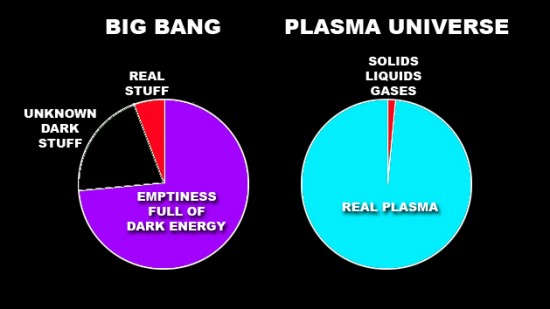
The big bang universe where 96% of the universe is imaginary. The plasma universe has >99% of the universe in the form of plasma and <1% solids, liquids and neutral gases.
The ‘Alice in Wonderland’ aspect of big bang cosmology is highlighted by the fact there is a competing ‘plasma cosmology,’ which is recognized by practical electrical engineers but unknown or dismissed by the mythmakers. Plasma cosmology deals with the dominant (>99%) form of matter in the visible universe. Plasma cosmology can demonstrate the formation and detailed rotation pattern of spiral galaxies, both by experiment and particle-in-cell computer simulation, using Maxwell’s laws of electromagnetism alone. The puny force of gravity can be ignored! Plasma cosmology can also explain the activity in the centres of galaxies without resort to the mythical dark gravitational beast — the ‘black hole.’ The Electric Universe goes further and also explains the gravitational effects observed at the center of the Milky Way in electrical terms. So much for the gravitational cosmology of the big bang! No invisible ‘dark matter’ need be conjured up and placed where needed to save the plasma model.
The most profound and important demand we must make of astrophysicists is to justify their unawareness of this freely available ‘second idea.’
‘Dark energy’ is supposed to make up 73% of the universe. The evidence interpreted in this weird way comes from comparing the redshift distances of galaxies with the brightness of their supernovae type 1a, used as a ‘standard candle.’ It was found that the supernovae in highly redshifted galaxies are fainter than expected, indicating that they are further away than previously estimated. This, in turn, implied a startling accelerating expansion of the universe, according to the big bang model. It is like throwing a ball into the air and having it accelerate upwards. So a mysterious ‘dark energy’ was invented, which fills the vacuum and works against gravity. The Douglas Adams’ “Infinite Improbability generator” type of argument was called upon to produce this ‘vacuum energy.’ The language defining vacuum energy is revealing: “Vacuum energy is an underlying background energy that exists in space even when the space is devoid of matter (free space). The concept of vacuum energy has been deduced from the concept of virtual particles, which is itself derived from the energy-time uncertainty principle.” You may notice the absurdity of the concept, given that the vacuum contains no matter, ‘background’ or otherwise, yet it is supposed to contain energy. Adams was parodying Heisenberg’s ‘uncertainty principle’ of quantum mechanics. Quantum mechanics is merely a probabilistic description of what happens at the scale of subatomic particles without any real physical understanding of cause and effect. Heisenberg was uncertain because he didn’t know what he was talking about. However, he was truthful when he wrote, “we still lack some essential feature in our image of the structure of matter.” The concept of ‘virtual particles’ winking in and out of existence defies the aforementioned first principle of physics, “Thou shalt not magically materialize nor dematerialize matter.” Calling that matter ‘virtual’ merely underscores its non-reality.
Indeed, the ‘discovery’ of the acceleration of the expanding universe is an interpretation based on total ignorance of the real nature of stars and the ‘standard candle,’ the supernova type 1a. A supernova type 1a is supposed to be due to a hypothetical series of incredible events involving a white dwarf star. But as I have shown, a supernova is simply an electrical explosion of a star that draws its energy from a galactic circuit. The remarkable brilliance of a supernova, which can exceed that of its host galaxy for days or weeks, is explained by the kind of power transmission line failure that can also be seen occasionally on Earth. If such a circuit is suddenly opened, the electromagnetic energy stored in the extensive circuit is concentrated at the point where the circuit is broken, producing catastrophic arcing. Stars too can ‘open their circuit’ due to a plasma instability causing, for example, a magnetic ‘pinch off’ of the interstellar Birkeland current. The ‘standard candle’ effect and light curve is then simply due to the circuit parameters of galactic transmission lines, which power all stars.
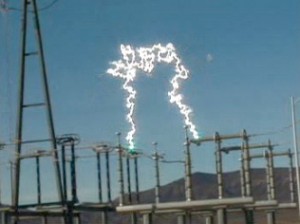
Spectacular arcing at a 500,000 Volt circuit breaker.
What of the fainter and more short-lived supernovae in highly-redshifted galaxies? Arp has shown that faint, highly-redshifted objects, like quasars, are intrinsically faint because of their youth and not their distance. Quasars are ‘born’ episodically from the nucleus of active galaxies. They initially move very fast along the spin axis away from their parent. As they mature they grow brighter and slow down, as if gaining in mass. Finally they evolve into companion galaxies. The decreasing quasar redshift occurs in discrete steps which points to a process whereby protons and electrons go through a number of small, quantized (resonant) increases in mass as the electrical stress and power density within the quasar increases. The charge required comes via an electrical ‘umbilical cord,’ in the form of the parent galaxies’ nuclear jet. Based on Arp’s discovery and the electric model of galaxies and stars, both stars and supernovae type 1a are naturally dimmer, and the supernovae more short-lived, in high-redshift galaxies than in low-redshift galaxies because of the smaller galactic power density and lower mass (energy) of all subatomic particles making up the former.
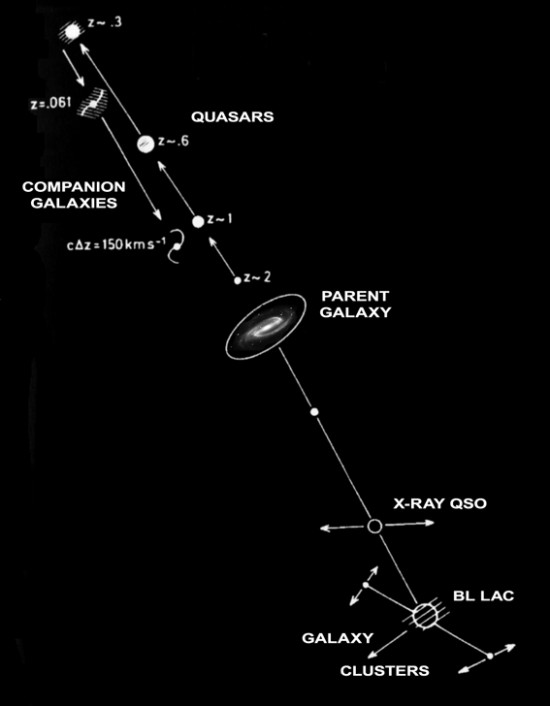
Arp's galactic 'family tree' showing birth of quasars with high-redshift (z) which decreases stepwise as they age and eventually form companion galaxies and progenitors of galactic clusters.
But I don’t expect a Nobel Prize for this sensible explanation. Otherwise I could meet the fate of the hapless student who created the ‘Infinite Improbability generator’ in Douglas Adams’ wonderful Hitchhiker’s Guide to the Galaxy:
“when just after he was awarded the Galactic Institute’s Prize for Extreme Cleverness he got lynched by a rampaging mob of respectable physicists who had finally realized that the one thing they really couldn’t stand was a smart-ass.”
The use of the title The Dark Side for Dr. Davis’ cosmology talk seems unconsciously apposite. It was Joseph Campbell who said, “We live our mythology.” And George Lucas attributes the success of his Star Wars films, which rely on a degenerate, evil ‘dark side,’ to reading Campbell’s books. The triumph of the big bang myth over common sense and logic supports Campbell’s assessment. And the showbiz appeal of Lucas’ mythic approach to storytelling is evident in the ‘dark side’ of cosmology. Scientists live their mythology too. Science’s “cosmic confusion” is self-inflicted.
The Electric Universe paradigm is distinguished by its interdisciplinary origin in explaining mythology by the use of forensic scientific techniques. It demands the lonely courage to give up familiar landmarks and beliefs. Sitting in the tame audience the other evening, listening to the professor of astrophysics, I was reminded of The Galaxy Song from Monty Python, which ends with the painfully perceptive lines, “And pray there is intelligent life somewhere up in space, ‘cause there’s bugger-all down here on Earth!”
Wal Thornhill
Peer-review of Plasma Cosmology
The Bentham Open Astronomy Journal has now published a “Special Edition” ([Special Issue #002] [Pp. 162-210]) with a focus on Plasma Cosmology. The issue titled “Some Initial Thoughts on Plasma Cosmology” features an editorial of the same title by Jeremy Duning-Davies.
The Open Astronomy Journal is an Open Access online journal which publishes research articles, reviews, letters and guest edited single topic issues in all areas of astronomy and astrophysics. A peer-reviewed journal, it aims to provide the most complete and reliable source of information on current developments in the field, with an emphasis on publishing quality papers rapidly and freely available to researchers worldwide.
The issue contains five papers in total, as follows:
Editorial: Some Initial Thoughts on Plasma Cosmology
Jeremy Dunning-Davies Pp 162-164
(27 August, 2011)
[DOI: 10.2174/1874381101004010162]
On Gravity-centric Cosmology and the Implications of a Universe Awash with Plasma
David B. Smith Pp 165-179
(27 August, 2011)
[DOI: 10.2174/1874381101004010165]
Electric Currents Key to Magnetic Phenomena
Donald E. Scott Pp 180-184
(27 August, 2011)
[DOI: 10.2174/1874381101004010180]
Laboratory Modeling of Meteorite Impact Craters by Z-pinch Plasma
C. J. Ransom Pp 185-190
(27 August, 2011)
[DOI: 10.2174/1874381101004010185]
Toward a Real Cosmology in the 21st Century
Wallace W. Thornhill Pp 191-210
(27 August, 2011)
[DOI: 10.2174/1874381101004010191]
This is the first time papers relating to Plasma Cosmology and our Electric Universe have been grouped together in one peer-reviewed publication and we at The Thunderbolts Project congratulate the authors on an outstanding achievement.

